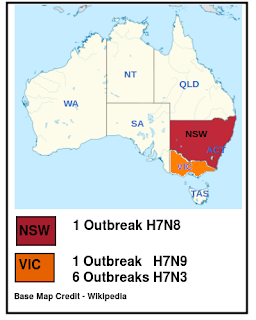
#18,134
It's turning into a tough avian flu season in southeastern Australia, with New South Wales now reporting an outbreak of H7N8 after neighboring Victoria - over the past month - having announced 7 outbreaks (1-H7N9 & 6-H7N3) in poultry.
With 3 different subtypes, these outbreaks appear to be due to at least 3 different spillovers of LPAI H7 viruses from wild birds into poultry, making the NSW outbreak unrelated to the Victorian cases.
Details remain scant, with the following notice posted a few hours ago on the NSW DPI website.
The Minister of Agriculture for NSW released the following statement:
NSW Government’s Biosecurity plan launched after Avian Influenza detected
Minister for Agriculture and Western NSW - Media Release
19 Jun 2024
The NSW Government has enacted its emergency biosecurity incident plan to address the detection of avian influenza in the Hawkesbury district on a poultry egg farm, that has been confirmed as the High Pathogenicity Avian Influenza (HPAI).
This analysis was confirmed by the CSIRO national testing labs, the Australian Centre for Disease Preparedness today.
The HPAI detected is the H7N8 type and is not the same strain as the current Victorian outbreak. It is understood at this point to be a separate spill-over event, potentially from wild birds.
High pathogenic diseases spread quickly and have a high mortality rate amongst poultry birds, which is why there has been an immediate lock down of the farm.
The detection has triggered the NSW Government’s Emergency Animal Disease response, including an individual biosecurity direction to the farm and business, closing it off.
Under the individual direction the affected egg farm has implemented quarantine to prevent the movement of equipment, and animals, to stop further spread.
A formal control order will be declared this afternoon that will extend biosecurity control to a radius of 1-2 kilometres around the farm site.
The legal instrument will guide the urgent actions of depopulating poultry and decontaminating the farm.
The Government’s Biosecurity Incident Management Team is now up and running and has been liaising with the Consultative Committee on Emergency Animal diseases to discuss immediate response plans and the National Emergency Animal Disease Management Group.
NSW consumers should not be concerned about eggs and poultry products from the supermarkets.
This detection does not pose a risk to consumer health and the products are safe to consume, if they are handled and cooked as per standard food handling practices.
The Government will work closely with industry to reduce the risk of spread and minimise any impact on egg supply.
As outlined in yesterday’s Budget, the NSW Government takes biosecurity threats seriously with $946 million invested for protecting our State and our primary industries.
Detections like this demonstrate our Biosecurity system and plan is working to detect incursions when they occur, and then taking swift action to contain, manage, eradicate, and decontaminate.
Information on aviation influenza is available at the Department’s website here. This website will be updated as information comes to hand.
This is the first outbreak reported by NSW since 2013, when two farms were hit with H7N2 near Young. The only other outbreak in NSW was reported a year earlier, when H7N7 struck a single farm near Maitland.
Like everywhere else in the world, LPAI viruses are common in Australian birds. Most are considered innocuous to poultry and humans, but when an H5 or H7 LPAI virus spreads among poultry, it can sometimes spontaneously mutate into an HPAI strain.
Hence the OIE/WOAH requirements to report, and quickly eradicate, all H5 and H7 outbreaks in poultry.
H7 viruses remain primarily a concern for poultry producers, with human infections up until 2013 being both rare and generally mild. But the H7N9 virus which emerged in China in 2013 showed us that - with the right set of mutations - an H7 virus can become a formidable public health threat.
H7N9 Epidemic Waves - June 14th 2017 - Credit FAO
For now, the H7 viruses circulating in Australia show no signs of posing any kind of serious public health threat.


